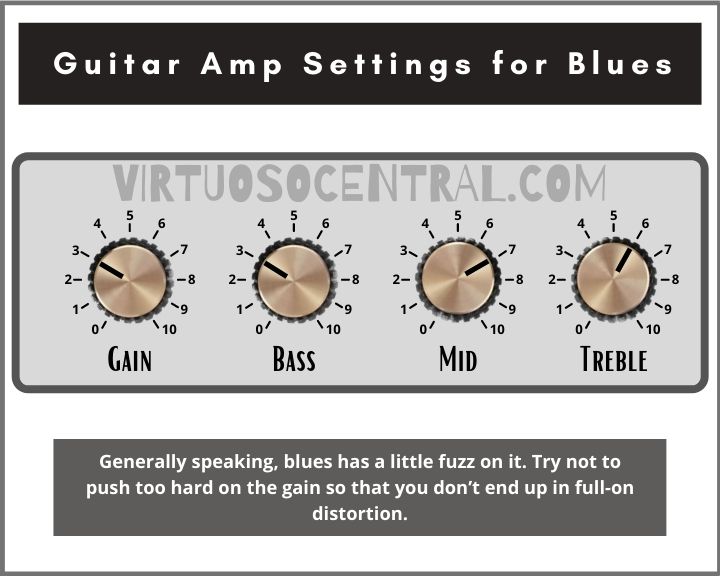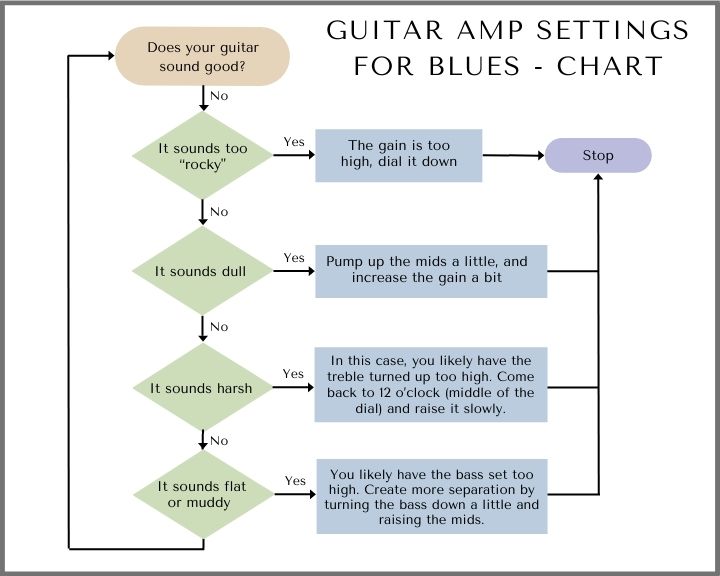Blues is the perfect style of music to learn once you have the basics of playing guitar under your belt. The rhythms are straightforward and translate well into other genres. And the blues scale is the second easiest to learn after the pentatonic scale.
But how do you get the best tone while you’re playing blues?
The tone is sometimes just as important as what you play in recreating the vibe of a genre.
While some amps outshine the competition in terms of the perfect blues sound, using the right EQ settings on your amp will help you get the best out of what you already have.
This article will dive into the best amp settings for blues to create a crunchy and clear blues tone on just about any amp. So, read on to master your amp for this popular genre of guitar intensive music.
A Basic Outline of Guitar Amp Settings for Blues
A good starting point for setting up your amp for blues would be to try out these settings:
- Gain or Drive: 3 or less
- Bass: 3
- Mids: 7
- Treble: 6
Generally speaking, blues has a little fuzz on it. Try not to push too hard on the gain so that you don’t end up in full-on distortion.

Tweaking Your EQ Amp Settings for Blues
Although we’ve given you a starting place to find the best tone for blues, each amp is different. You’ll need to adjust the settings to get the most appropriate tone from your particular amplifier.
Also, keep in mind that artists use many EQ settings themselves. You may have to make further adjustments if you want to play along to a particular song and sound as close as possible to the original.
To achieve this, you need to know how to adjust the EQ correctly and know what each knob does to the sound. So, let’s take a look at how you can tweak each setting on your amp.
Gain/Drive
This controls how much crunch you get through your amp. Turn it up, and you’ll get more distortion. Simple as that.
However, many of us get carried away with the gain, especially when we need more volume in a band setting. Try to use the volume controls instead. We’re not playing metal, after all.
You likely have too much distortion if you’re playing blues and your gain is set higher than five. Dial it back a little.
Bass
Start low. But there’s no reason you couldn’t crank the bass a little. Generally speaking, you’ll want to leave a little space in the lower frequencies. Yet, if you’re playing in a band with no bass player, sometimes it’s good to fill that space with some guitar.
Be wary that you don’t end up with a muddy mess from too much bass. Listen as you play and adjust accordingly.
Mids
Having a present mid-range allows the guitar in blues bands to cut through the mix. You’ll want to start with these anywhere above five but may wish to increase up to eight.
Another thing to keep in mind is the other instruments in your band. If you’re playing with a keys player or brass instruments, you may want to dial your mids back a little so that the tone from the guitar doesn’t collide with the rest of the band.
Remember that you want to deliver a balanced, mellow sound to your listeners.
Treble
As you’re probably working on your lead guitar skills when you play blues, feel free to crank the treble a little. Just be wary that too much treble can cause a shrill sound. Again, listen as you play and make adjustments as you go.
Practice Makes Perfect
The key to dialing in the “right” guitar amp settings for blues depends on your taste or the artist you’re trying to emulate.
It’s unlikely you’re going to get it exactly right the first time you try to make adjustments, but your ear will get better over time, and you’ll be able to recognize what you need more of and what is overbearing.
Some simple indications to change the variables could be:
It sounds too “rocky” — In this case, you almost definitely have the gain set too high. Dial it back down to around two and work your way up slowly again.
It sounds dull — Pump up the mids a little and maybe add a little more reverb into the mix. If your amp doesn’t have reverb and you don’t have a pedal, you could try adding a little more gain. But, again, don’t go overboard with the gain settings.
It sounds harsh — In this case, you likely have the treble turned up too high. Come back to 12 o’clock (middle of the dial) and raise it slowly.
It sounds flat or muddy — You likely have the bass set too high. Create more separation by turning the bass down a little and raising the mids. Doing so should help create a more precise tone.
Guitar Amp Settings for Blues Flowchart Diagram Cheatsheet

What Makes a Good Blues Amp?
Most amp manufacturers make amps that are perfect for blues. A good example is the Fender Blues Deluxe. I mean, it’s in the name, right?
Just because there are many dedicated blues amps on the market doesn’t mean you have to spend a fortune on the perfect amp. In fact, blues is one of the most forgiving genres in terms of the type of amp you use.
As long as you can get a touch of overdrive through your amp without making the signal too wet, you’ll be fine.
A two-channel amp is ideal for blues. You’ll pretty much always want a little bit of crunch. But, plenty of famous blues artists use a clean tone too. John Mayer is a prime example of this.
Using Pedals to Supplement Your Amp Setting for Blues
You could use a few different types of pedals to get a better tone from your amp. We’d recommend the following:
Fuzz/Overdrive
If your amp does not have a decent overdrive channel built-in, you’ll need a fuzz pedal to give you that little bit of bluesy crunch.
Don’t go for a distortion pedal. You won’t need anywhere near that kind of rough signal.
A couple of classic fuzz pedals that deliver excellent overdrive are the Electro-Harmonix Op-amp Big Muff Pi and the Dunlop FFM3 Jimi Hendrix™ Fuzz Face®. Any of these effects will create overdriven melodic overtones perfect for blues.
Reverb
Pretty much every blues song ever written has a little reverb. This can be true for the entire track, but the guitars significantly benefit from reverb.
If you’re switching between a clean and dirty tone throughout your set, make sure you have adjustable reverb too. This will allow you to keep a consistently excellent sound.
You obviously won’t need a pedal if your amp has a built-in reverb effect.
Start with the reverb sitting at around two and bring it up as you go. Many blues artists use extremely saturated reverb on their clean channels for certain songs. Don’t be afraid to crank it for some songs, but don’t play a whole set like that. It gets a bit much.
Here are some of the best reverb pedals in the market to name a few:
Bonus: Loop Pedal
As we mentioned earlier, playing blues is a fantastic way to up your guitar game. This is especially true when working on your lead guitar chops.
Although it won’t really impact your tone, using a loop pedal will allow you to practice your timing (making the loops) and your solos and leadlines. You can just constantly practice some licks over the top of your recorded chords.
Rinse and repeat for different keys. You’ll be a master of the fretboard in no time.
Learn More About EQ
Keep at it, and eventually, you’ll be a master at getting your amp to sound like a blues powerhouse. Hopefully, by then, you’ll be playing in a band. Be prepared by checking out our other EQ articles to learn as much as you can about creating the perfect band-wide tone.
You may find these articles helpful: